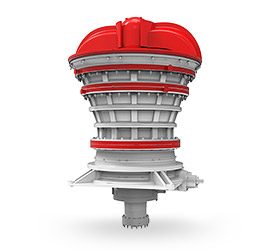The concave and mantle are critical components of a cone crusher, responsible for the crushing action. Here’s a breakdown of their roles, differences, and maintenance considerations:
1. Cone Crusher Concave & Mantle Functions
– Concave (Fixed Liner):
– A stationary outer surface that forms the crushing chamber.
– Acts as the surface against which the mantle crushes the material.
– Typically made of high manganese steel or other wear-resistant alloys.
– Mantle (Moving Liner):
– The rotating inner component that gyrates within the concave.
– Compresses and crushes rock/ore against the concave.
– Also made from wear-resistant materials but wears faster than the concave.
2. Key Differences
| Feature | Concave | Mantle |
|—————|———|——–|
| Position | Outer stationary part | Inner moving part |
| Movement | Fixed (attached to bowl) | Moves eccentrically |
| Wear Rate | Slower (due to less direct impact) | Faster (due to constant movement) |
| Shape | Curved inward to form chamber | Conical shape matching concave |
 3. Wear & Replacement
3. Wear & Replacement
– Both parts wear over time due to abrasion and compression.
– Uneven wear can reduce crushing efficiency or cause damage.
– Signs of wear:
– Reduced throughput.
– Poor product size/shape.
– Increased power consumption.
– Replace when worn beyond tolerance (~60–70% loss).
4. Material Selection
Common materials include:
– Manganese steel (Mn14%, Mn18%, Mn22%) – Good toughness & work hardening.
– Chrome-moly alloys – Higher abrasion resistance for hard rock.
– Composite alloys – For extreme conditions.
5. Maintenance Tips
1. Regularly check liner thickness with gauges.
2. Monitor feed size to avoid excessive wear from oversized material.
3. Ensure proper crusher settings (CSS – Closed  e Setting).
e Setting).
4. Rotate/swap concaves if asymmetrical wear occurs.
6. OEM vs Aftermarket Parts
– OEM parts ensure exact fit but are costly.
– Aftermarket alternatives can be cost-effective but vary in quality.
Would you like details on installation procedures or troubleshooting specific issues?





Leave a Reply